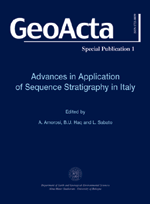Abstract
The high valley of the Agri River (southern Apennines) is a wide intermontane basin, formed during the Quaternary, in which are stored relevant water resources. The stratigraphic succession includes the Jurassic to Oligocene ophiolite-bearing Ligurian Unit, the Mesozoic-Cenozoic shallow-water carbonates of the Campanian-Lucanian platform, and the lower-middle Triassic to lower-middle Miocene shallow-water and deep-sea formations of the Lagonegro basin. The basin floor is filled by middle Pleistocene faulted alluvial deposits
The aquifer system is mostly made up of Cretaceous carbonate rocks, and is fed mainly from infiltration of rainwaters through the carbonate outcrops. A growing interest is focused on this area due to the environmental impact of factory plants and oil extraction fields.
The siliciclastic sediments cropping out in the high Agri valley can retain significant amounts of As and first row transition elements, especially Cr, Ni, and Cu. The concentrations of As and Cu can be well above the UCC contents also in some carbonate samples.
The springs have a Ca-HCO3 composition and, overall, the features of the waters are those typically observed in groundwaters rising from a carbonate aquifer. The concentrations of As and first row transition elements are below the maximum permissible level for drinking waters, as fixed by the Italian regulations. The availability of As, Pb, Cu, Zn, and Fe may be related to the occurrence of iron oxi-hydroxides. Redox changes affecting the stability of iron oxi-hydroxides may be responsible for the release of these ions to the solution.
In some springs the use of fertilizers can seriously affect the availability of nitrate concentrations and, in addition, of alkalys.
Keywords: Agri River, Hydrogeochemistry, Sediments, Statistical analysis


